

Xiang Gate is renovated in a new style, with paving bricks on the facade to create more space inside. — Cindy Jiang
Bathed in rosy autumn sunset glow, I stood on the top of the Xiang Gate, one of the eight main gates of the Suzhou city wall, and had a bird's-eye view of the old city and the canal surrounding the old city.
Spread before me was the bustling city, with office workers and students rushing home for dinner, bridges crowded with cars and bicycles and old streets warmed up by cafes and bars.
Standing on the wall dating from the Spring and Autumn Period (770-476 BC), I was reminded of a time tunnel stretching from China's ancient grandeur and frequent battles to the present day of a modern metropolis.
Suzhou's city wall with eight gates is one of the most sophisticated and best preserved in China. It's one of the few employing both defensive land and water gates in a region criss-crossed by streams and canals. Since river traffic was essential — the Grand Canal itself passes through the city — passage could not be blocked, but during conflicts, gates over the water were closed to prevent enemies from flooding into the city.
It's also famous for double-wall fortifications where enemies could be trapped and killed if they breached the outer wall.
The structure represents the highest level of architecture and engineering at the time. It was not typically square and straight, but irregularly shaped to take advantage of the area's natural defenses and surroundings of water and mountains. In that sense, the design is very modern.
The total perimeter is 15,204 meters, with 1,250 meters of relatively intact sections, according to a government survey.
2,500 years of history
I was anxious to climb the walls and "hear" their tales. When I walked up a broad ramp to the Pan Gate watchtower, I ran my fingers over the bricks. I could read the carved characters for the date of Suzhou's founding in 514 BC, when construction on the original wall began.
Suzhou in southeastern Jiangsu Province and its walls date back more than 2,500 years. The city walls we see today were rebuilt over the centuries and a major restoration took place in the 1980s, using foundation of the walls from the early Qing Dynasty (1644-1911). The Pan Gate and Xu Gate were built in the Yuan Dynasty (1271-1368), and parts of them remain today, notably the Pan Gate, a major tourist attraction.
When it was built in 514 BC by King Helu of Wu during the Spring and Autumn Period, the walls were made of rammed earth, with eight gates including Chang, Xu, Pan, She, Lou, Xiang, Ping and Qi gates. After gunpowder was invented, rammed earth could no longer resist assault. In AD 922, King Qian Yuanliao of Wuyue built solid brick walls, the earliest brick walls in Suzhou. In the Southern Song Dynasty (1127-1279), the walls were extended and parapets were added both for defense and for firing cannon.
"Most people think everything in Suzhou is elegant and exquisite, like the classical gardens and bridges. And the city walls are no exception," said Shi Xiaoping, a history and culture expert advising the government. "The structure is not only very large, but also very complicated."
Shi has visited and researched city walls throughout China and considers the Suzhou walls one of the most sophisticated, finest and best preserved in the country. He considers it a "fossil" representing the layout, architecture and culture of the ancient city and the prosperous region south of the Yangtze River. It protected all the city's achievements, both intellectual and physical, its classical gardens, bridges, pagodas and temples.
Unlike the straight lines of the city walls in Beijing and Xi'an, Suzhou's were originally designed in the general shape of the Chinese character "亚" meaning highest excellence. Today it's a rough rectangle.
Pan Gate
Spectacular Pan Gate was the major entrance to the walls that surrounded ancient Suzhou. It is famous for its architecture and watchtower as well as its combination of land and water gates. It's sometimes called the Land and Water Gate.
Located in the old city in Gusu District, it's the best preserved of the old city walls and a major tourist attraction. The solid walls are 9 meters thick and more than 8 meters high. Fortified enclosures cover 1.3 hectares.
It contains one land and one water gate (which contains two smaller water gates), and an enclosed courtyard between inner and outer stone walls. If the enemy breached the outer perimeter, they were trapped and attacked inside the enclosure by defenders who stood above on the parapets and fired weapons down upon them. The inner enclosure has a perimeter of 177 meters, a small kill space.
Combining land and water gates was a major military invention. The water gates built over canals not only repelled invaders on water but also helped control floods during heavy rains, and facilitated traffic.
Today the former military and transport hub is filled with tourists.
I saw one forelorn, rundown boat on the small water gate canal. Cruise boats ply the larger canal around the city.
Copyright ©1999-2018
Chinanews.com. All rights reserved.
Reproduction in whole or in part without permission is prohibited.